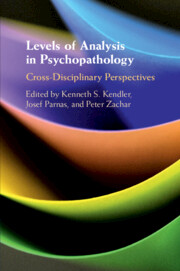Book contents
- Levels of Analysis in Psychopathology
- Advance Praise for Levels of Analysis in Psychopathology
- Levels of Analysis in Psychopathology
- Copyright page
- Contents
- Figures
- Tables
- Contributors
- Preface
- General Introduction
- Part I Neuroscience, Mechanisms, and RDoC
- Part II Phenomenology, Biological Psychology, and the Mind–Body Problem
- Part III Taxonomy, Integration, and Multiple Levels of Explanation
- Index
- References
2 - Rethinking Psychiatric Disorders in Terms of Heterarchical Networks of Control Mechanisms
from Section 1
Published online by Cambridge University Press: 02 April 2020
- Levels of Analysis in Psychopathology
- Advance Praise for Levels of Analysis in Psychopathology
- Levels of Analysis in Psychopathology
- Copyright page
- Contents
- Figures
- Tables
- Contributors
- Preface
- General Introduction
- Part I Neuroscience, Mechanisms, and RDoC
- Part II Phenomenology, Biological Psychology, and the Mind–Body Problem
- Part III Taxonomy, Integration, and Multiple Levels of Explanation
- Index
- References
Summary
This chapter offers a framework for understanding mechanistic explanations of psychiatric disorders in terms of altered activities in a heterarchical network of control mechanisms. This differs both from approaches that seek to characterize the mechanism responsible for producing the disease state and those that attribute the disease state to broken mechanisms. Control mechanisms operate on soft constraints in other mechanisms and thereby alter their operation. Although often viewed as hierarchical, the brain is organized as a heterarchical network, with many control mechanisms operating on the same controlled mechanisms and no chief executive. This poses challenges for attempts to understand the ramifications of altered functioning of components of the network. Using a recent example of research showing the effects of modifying the activity of proteins within the circadian clock on depression-like behavior in mice, this chapter illustrates how progress might be made as well as the challenges faced in explaining psychiatric disorders.
Keywords
Information
- Type
- Chapter
- Information
- Levels of Analysis in PsychopathologyCross-Disciplinary Perspectives, pp. 24 - 46Publisher: Cambridge University PressPrint publication year: 2020
References
Accessibility standard: Unknown
Why this information is here
This section outlines the accessibility features of this content - including support for screen readers, full keyboard navigation and high-contrast display options. This may not be relevant for you.Accessibility Information
- 5
- Cited by
